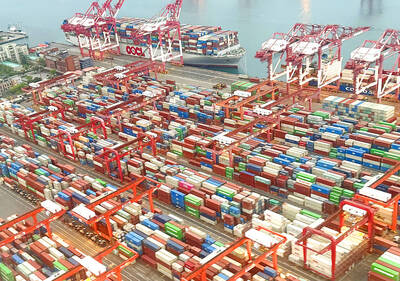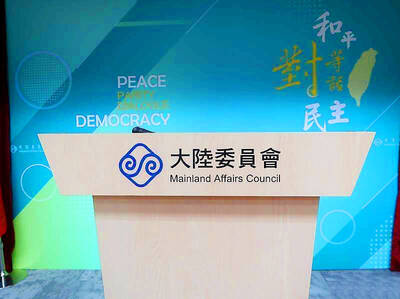The first of Boeing Co's highly anticipated 787 jetliners is on track for a "power on" milestone next month and subsequent planes are arriving at the final assembly floor in better and better shape, the executive in charge of the 787 program says.
Boeing invited reporters into its 40-hectare production area on Monday to show that the aircraft maker has overcome parts shortages and hiccups in its new, decentralized manufacturing model and is making steady progress toward the 787’s first flight.
Last month, Boeing postponed the jet’s debut in commercial service until the third quarter of next year. The latest delay was the third revision to its delivery schedule. The delays will likely cost the company billions of dollars in additional costs and penalties.
Inside the massive hangar, four planes were lined up nose-to-tail in varying states of completion.
Patrick Shanahan, general manager for the 787 program, said the mood on the assembly floor had shifted from frustrated to fired-up in the last two months as the installation of critical systems on Plane No. 1 neared completion.
But despite seven-day work weeks, Shanahan also said he expects some of the pieces of the first plane to come together at the last moment in a “photo finish,” and joked that someone tosses the equivalent of a grenade into his office every half hour or so.
Powering up the 787 for the first time — a major milestone, but one of many that remain before Boeing can deliver the first of its new planes — will show the company how successful its next-generation production model really is.
The firm relied almost entirely on outside companies around the world to manufacture, test and put together major parts of the aircraft before shipping them to Everett, Washington, for final assembly.
The 787, Boeing’s first newly designed jet since airlines started flying the 777 in 1995, will be the world’s first large commercial airplane made mostly of carbon-fiber composites, which are lighter and more durable than aluminum and don’t corrode like metals.
Boeing says it will be cheaper to maintain and offer greater fuel efficiency than comparable planes.
The final assembly phase was meant to be less labor-intensive than the assembly of traditional metal commercial airplanes.
As an example, Shanahan said workers had to drill more than a million holes to assemble a 747 but less than 10,000 to put together the major components of a 787.
But Plane No. 1, which sits at the front of the production line, arrived in Washington with far fewer parts pre-installed than Boeing expected.
The factory floor was not designed to accommodate the extra work, as evidenced by ad-hoc scaffolding that still surrounds the planes, and local laborers were left with a much longer to-do list than they had planned.
Shanahan said partner companies have since gained a clearer understanding of what’s required. He reported that the fourth plane’s components arrived in Everett much closer to the state in which Boeing expected them.
Beyond the power-on testing, the 787 must clear several hurdles to assure the Federal Aviation Administration that it’s ready for commercial service.
In early July, engineers are set to begin a process of testing the plane’s structural limits by simulating extreme conditions. During that so-called “static testing” phase, engineers will compare the test results with their predictions about how the 787, with its new materials, design and manufacturing process, should fare in extreme conditions.
“This is the graduation event, if you will, for the 787,” said Randy Harley, vice president of engineering and technology for the 787.

CARROT AND STICK: While unrelenting in its military threats, China attracted nearly 40,000 Taiwanese to over 400 business events last year Nearly 40,000 Taiwanese last year joined industry events in China, such as conferences and trade fairs, supported by the Chinese government, a study showed yesterday, as Beijing ramps up a charm offensive toward Taipei alongside military pressure. China has long taken a carrot-and-stick approach to Taiwan, threatening it with the prospect of military action while reaching out to those it believes are amenable to Beijing’s point of view. Taiwanese security officials are wary of what they see as Beijing’s influence campaigns to sway public opinion after Taipei and Beijing gradually resumed travel links halted by the COVID-19 pandemic, but the scale of

TRADE: A mandatory declaration of origin for manufactured goods bound for the US is to take effect on May 7 to block China from exploiting Taiwan’s trade channels All products manufactured in Taiwan and exported to the US must include a signed declaration of origin starting on May 7, the Bureau of Foreign Trade announced yesterday. US President Donald Trump on April 2 imposed a 32 percent tariff on imports from Taiwan, but one week later announced a 90-day pause on its implementation. However, a universal 10 percent tariff was immediately applied to most imports from around the world. On April 12, the Trump administration further exempted computers, smartphones and semiconductors from the new tariffs. In response, President William Lai’s (賴清德) administration has introduced a series of countermeasures to support affected

Pope Francis is be laid to rest on Saturday after lying in state for three days in St Peter’s Basilica, where the faithful are expected to flock to pay their respects to history’s first Latin American pontiff. The cardinals met yesterday in the Vatican’s synod hall to chart the next steps before a conclave begins to choose Francis’ successor, as condolences poured in from around the world. According to current norms, the conclave must begin between May 5 and 10. The cardinals set the funeral for Saturday at 10am in St Peter’s Square, to be celebrated by the dean of the College

CROSS-STRAIT: The vast majority of Taiwanese support maintaining the ‘status quo,’ while concern is rising about Beijing’s influence operations More than eight out of 10 Taiwanese reject Beijing’s “one country, two systems” framework for cross-strait relations, according to a survey released by the Mainland Affairs Council (MAC) on Thursday. The MAC’s latest quarterly survey found that 84.4 percent of respondents opposed Beijing’s “one country, two systems” formula for handling cross-strait relations — a figure consistent with past polling. Over the past three years, opposition to the framework has remained high, ranging from a low of 83.6 percent in April 2023 to a peak of 89.6 percent in April last year. In the most recent poll, 82.5 percent also rejected China’s